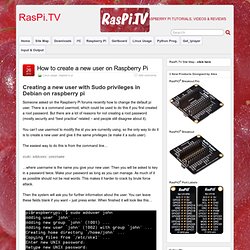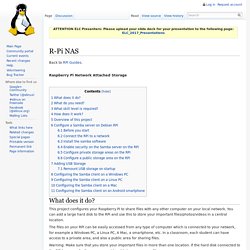

BTRFS. GPIO I2C. Watchdog. WiFi. RPi Resize Flash Partitions. This page describes activities relating to partitions on the Raspberry Pi for Linux based operating systems, such as Raspian Linux.

It may also apply to other operating systems too, but you should check. Incorrectly using the following instructions is likely to corrupt your system. The prepared images for the Raspberry Pi are created for SD cards of the size of 2GB. The SD card can be resized or restructured to use the full size of a SD card that is greater than 2GB. Raspi-config If using the Raspian or Debian images the raspi-config utility can be used to resize the main partition to fill the SD card. This will happen automatically. Explanation Backup You might want to backup your SD before resizing partitions. Manually resizing the SD card on Linux Tutorial video here: Following on from the instructions above, keep the newly-written SD card in the card reader, but unmounted. Show partition information to find your SD card $ df -h Unmount the partition $ umount /dev/sdc2 You're done!
Start fdisk: Users, Groups, adding users. How to create a new user on Raspberry Pi. Creating a new user with Sudo privileges in Debian on raspberry pi Someone asked on the Raspberry Pi forums recently how to change the default pi user.

There is a command usermod, which could be used to do this if you first created a root password. But there are a lot of reasons for not creating a root password (mostly security and “best practice” related – and people still disagree about it). You can’t use usermod to modify the id you are currently using, so the only way to do it is to create a new user and give it the same privileges (ie make it a sudo user). The easiest way to do this is from the command line… sudo adduser username …where username is the name you give your new user. Then the system will ask you for further information about the user.
Sudo adduser john Adduser will also create a home directory for the new user at /home/username After that you can give them sudo privileges by editing the sudoers file… sudo visudo pi ALL=(ALL) ALL john ALL=(ALL) ALL sudo user editing logout login. Databases on the Pi with SQLite. Sooner or later one of your projects is going to need to store some data; and what better place to store that data than a database?

This post is going to run through the basics of what you will need to do to get started with databases on your Raspberry Pi. To do so I am going to make use of a database technology called SQLite. SQLite is an excellent choice of database technologies to get started with on the Pi for a number of reasons: Obviously SQLite may not be the perfect choice for every project and if you want to read up some more about if it will be suitable for your particular project check out the page on their website.
But I suspect that SQLite will be a good fit for many projects on the Pi. I said that it was easy to install so here goes. Wait while it downloads and installs; and you are done. So now we have installed it, the next step is to create a database. Sqlite3 MyFirstDatabase.db You don't need to worry about any configuration options because there are none. .exit and then ls. Monitoring - How do I monitor and/or control the temperature of the SoC?
Current community your communities Sign up or log in to customize your list. more stack exchange communities Stack Exchange sign up log in tour help Raspberry Pi beta Ask Question.

R-Pi NAS. Back to RPi Guides.

Raspberry Pi Network Attached Storage This project configures your Raspberry Pi to share files with any other computer on your local network. You can add a large hard disk to the RPi and use this to store your important files/photos/videos in a central location. The files on your RPi can be easily accessed from any type of computer which is connected to your network, for example a Windows PC, a Linux PC, A Mac, a smartphone, etc. In a classroom, each student can have access to a private area, and also a public area for sharing files. Warning: Make sure that you store your important files in more than one location. Note: There are two major classes of Network Attached Storage Low-power NAS. This project does not require any coding or compilation. Unique serial number of rpi board.